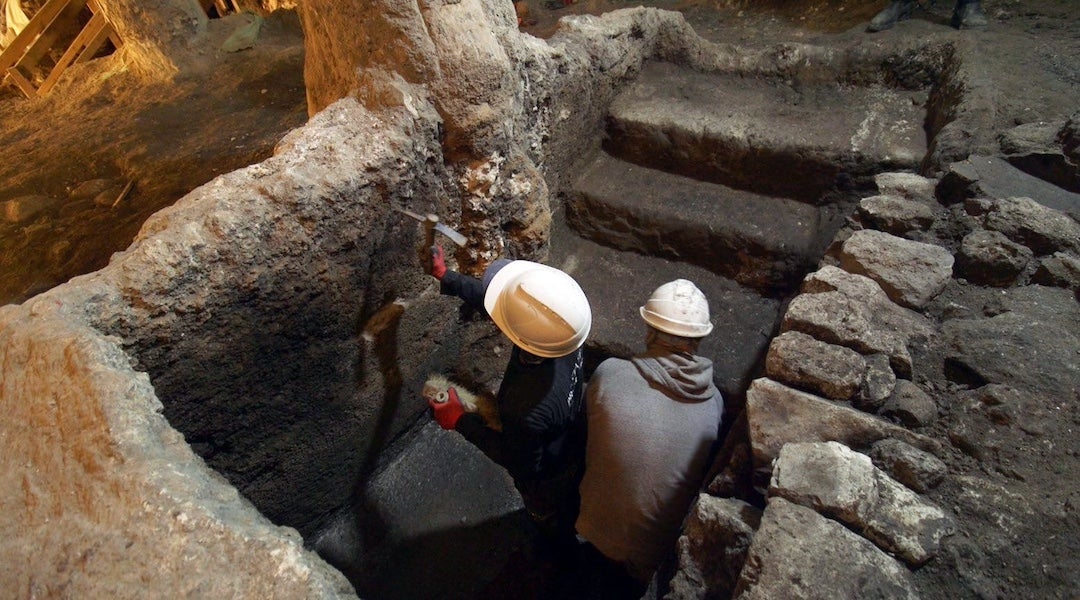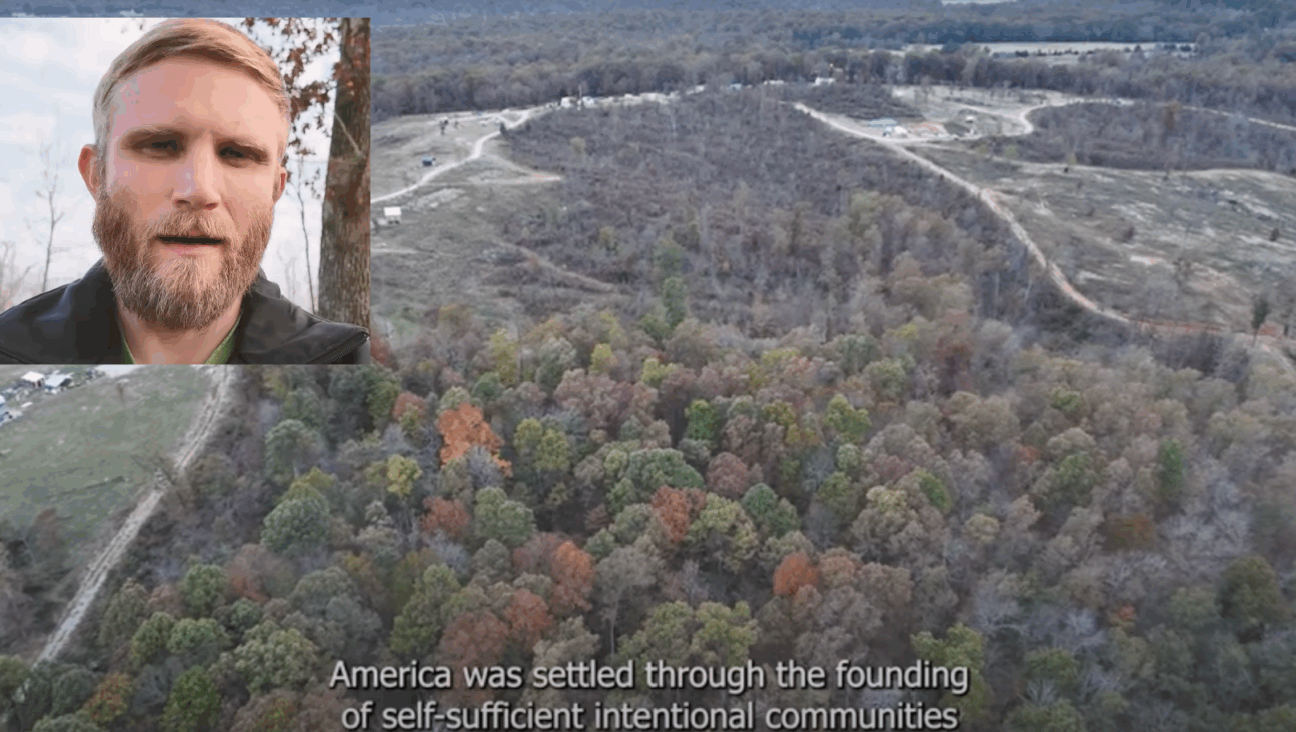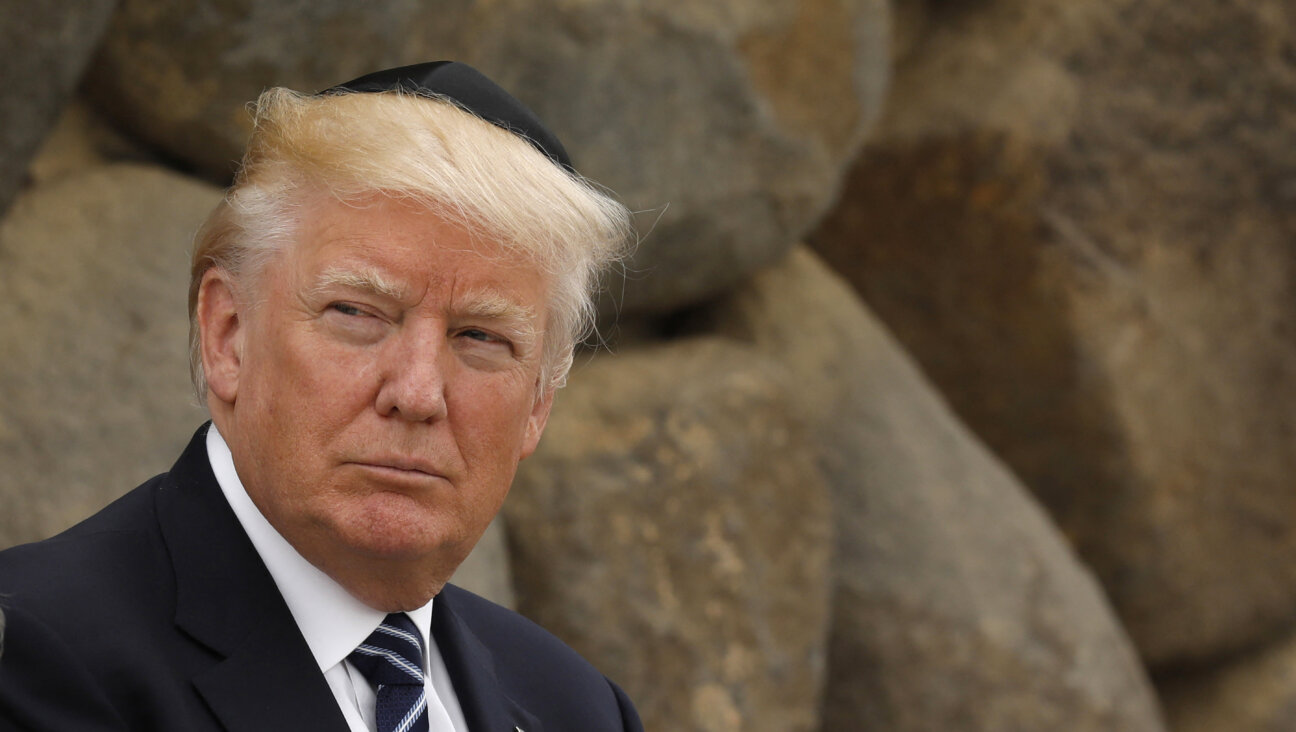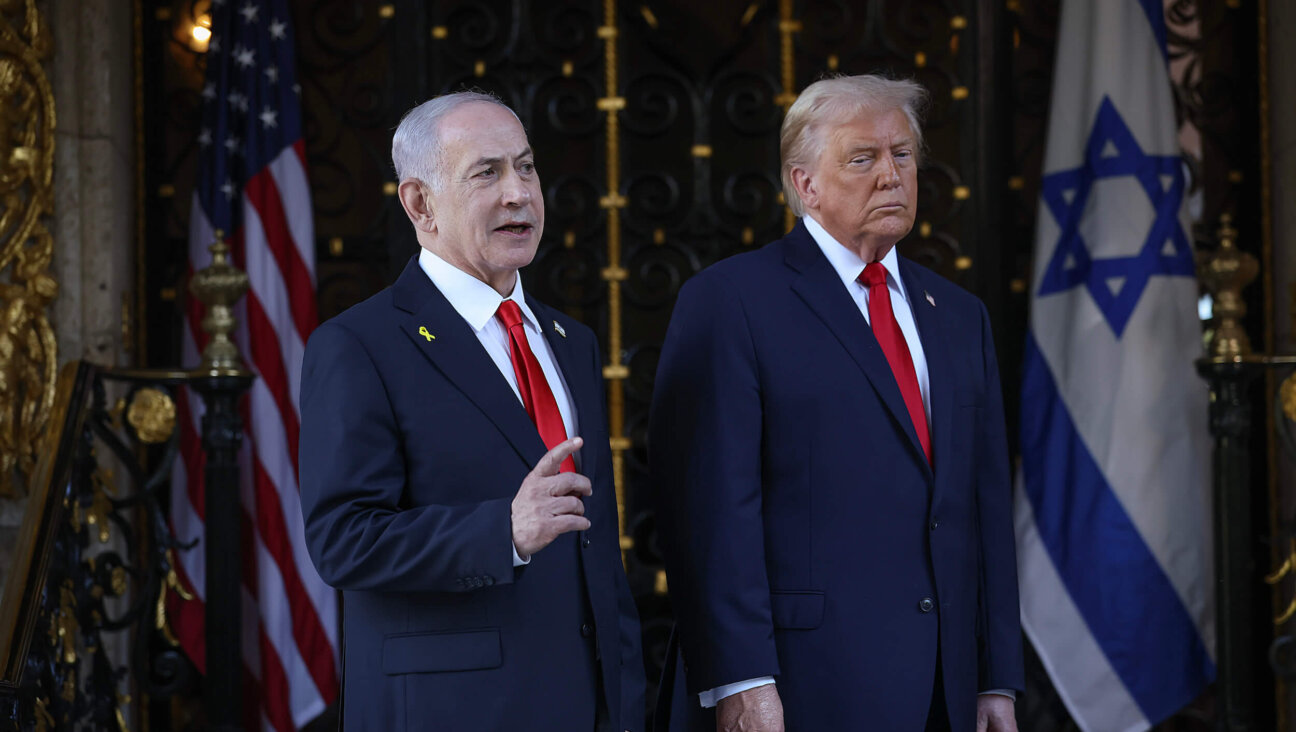New York Times adds editors’ note to front-page image of emaciated Gaza toddler after backlash
The dustup comes amid increasing pressure on Israel to let independent journalists work in Gaza
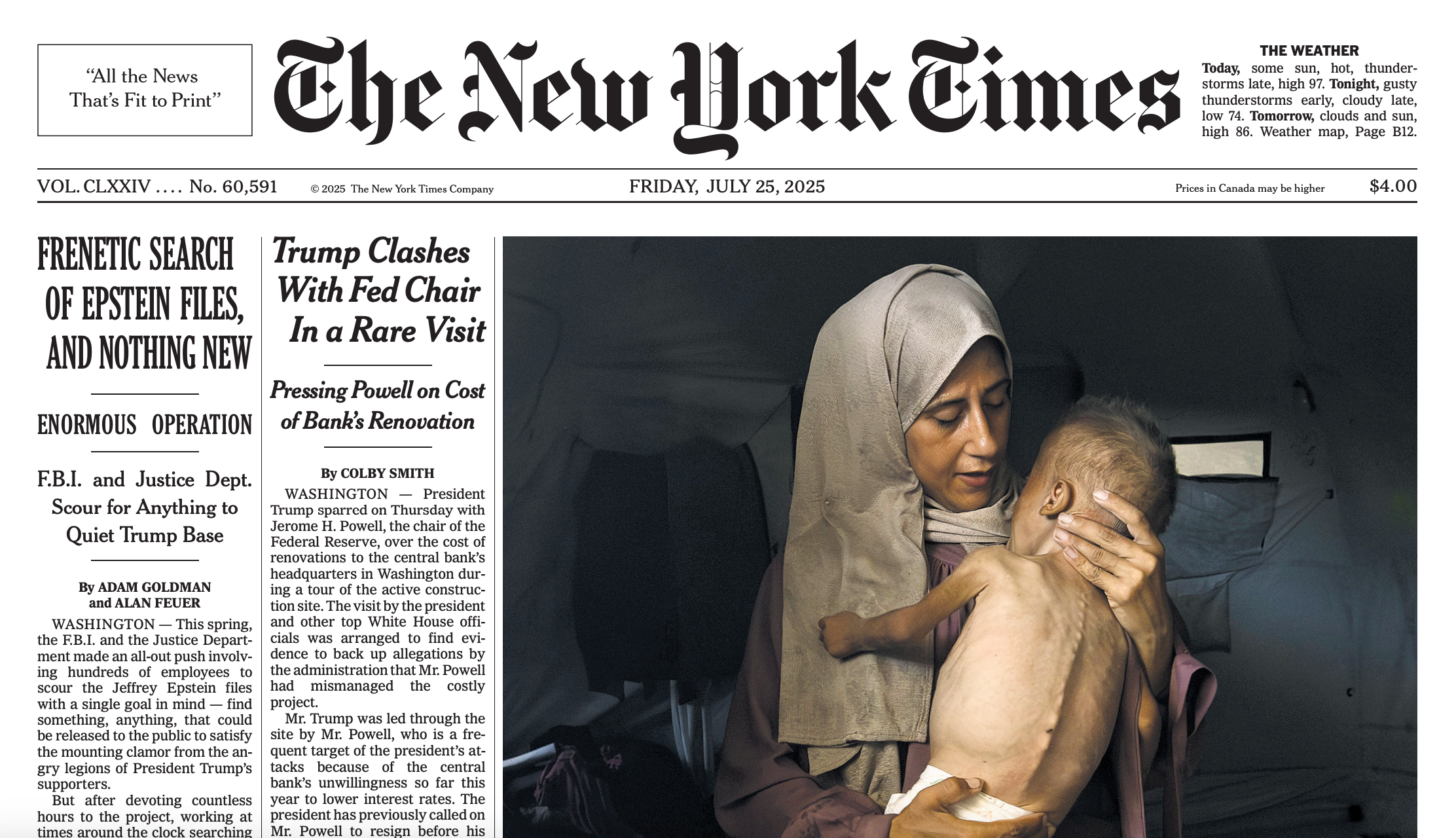
The cover image of the New York Times on Friday, July 25, showed a child the caption said had been born healthy before suffering malnutrition in Gaza. Screenshot of The New York Times
(JTA) — A haunting photo of an emaciated toddler cradled by his mother dominated the front page of Friday’s New York Times, quickly becoming a symbol of the hunger crisis in Gaza. Now, the newspaper has amended some aspects of his story amid criticism.
“Mohammed Zakaria al-Mutawaq, about 18 months, with his mother, Hedaya al-Mutawaq, who said he was born healthy but was recently diagnosed with severe malnutrition,” the original caption said.
But over the weekend, skeptics about the scope of the hunger crisis in Gaza — and especially about whether Israel is to blame — cried foul over the image and its use. They charged the newspaper with perpetrating a “blood libel” against Israel.
On Tuesday night, the newspaper announced that it had revised the story, saying that it had learned that the child had underlying medical issues that affected his muscle development. The revision removed the mother’s quote from the story saying that Mohammed had been born healthy and added context from his doctor, though it did not back away from the other reporting in the story, “Gazans Are Dying of Starvation,” including its claim that the child was suffering from malnutrition due to food shortages.
“This additional detail gives readers a greater understanding of his condition,” the newspaper said in a statement about an editors’ note appended to the story.
The editors’ note followed days of criticism of the newspaper and other outlets for running photographs that the critics said exaggerate the extent of hunger in Gaza and lay blame for any crisis solely at Israel’s feet.
“Muhammad is not simply a victim of starvation. His condition stems from a health disorder, not from a lack of food caused by Israel,” the pro-Israel media watchdog Honest Reporting wrote in a report issued Sunday titled “Another Photo. Another Lie.”
While Honest Reporting acknowledged that there is “suffering in Gaza,” it claimed that the blame lies with Hamas, which it accused of looting aid intended for civilians and disrupting Gaza’s medical system with its attack on Israel and continued hostage-holding.
“He is a sick child in need of medical care and specialized nutrition. Care that was once available, and could be again,” its report said.
Honest Reporting and other pro-Israel voices, including the Israeli government, have long accused various media organizations of distorting their presentation of the Israel-Hamas war to paint Israel in the harshest light possible. The challenges have picked up — and found purchase — as international attention has turned to a hunger crisis in Gaza.
In another incident this week, the Israeli agency responsible for aid in Gaza, COGAT, denounced the use of photographs of another emaciated Gazan boy, noting that he had been evacuated for medical treatment to Italy in June.
Allegations of distortion can cut both directions. An Israeli journalist this week accused COGAT of distorting public sentiment by distributing an image of Hamas fighters taking a selfie over a meal to make the case that Hamas was stealing aid intended for Gazans. The picture, Amos Harel wrote, citing Israeli army sources, was taken a year ago, long before the current crisis. The army declined to comment on the picture.
Together, the images and the disputes over them point to deep challenges in understanding and responding to conditions in Gaza, where Israel and Hamas have been battling for nearly 22 months. Israel has not allowed independent journalists to enter the territory, meaning that the professional images that emerge are taken by photographers who may be working with Hamas’ approval or otherwise conflicted about their subjects.
The New York Times is among a growing number of news organizations that called for Israel to lift restrictions on international reporters from independently entering the Gaza Strip, a policy it says has hindered reporting in the region. Independent media organizations regularly send their journalists into conflict zones in other parts of the world.
Philip Pan, the newspaper’s international editor, said in a statement on Sunday that its journalists in Gaza “face difficulty finding food and ensuring safe freedom of movement in order to do their jobs,” and would continue to push for its journalists to be “allowed to work securely and without fear or hesitation in Gaza.”
The disputed images are far from the only signs that there is a crisis in Gaza. While saying firmly that there is “no starvation” in the enclave, even Israeli officials have conceded that challenges with aid distribution have resulted in some places where hunger is acute.
A wide array of groups, including the United Nations, Doctors Without Borders and Oxfam, have said starvation is looming in the enclave.
Even the New York Times story featuring Mohammed quoted multiple physicians who said they were seeing patients in acute stages of hunger; some of the physicians said they themselves were going without adequate food. And many other independent news outlets have reported stories about acute hunger, sometimes including photographs of Mohammed alongside pictures of other emaciated children that have not been contested.
It is clear that images that emerge from Gaza are shaping the global response to the war, informing opinion and policy-making at the highest levels.
“That’s real starvation stuff. I see it, and you can’t fake it,” President Donald Trump said on Monday, during a meeting with British Prime Minister Keir Starmer, directly contracting Israeli Prime Minister Benjamin Netanyahu.
“I think people in Britain are revolted at seeing what they’re seeing on their screen,” Starmer said.
A day later, on Tuesday, Starmer announced that the U.K. will recognize a Palestinian state in September, a move that Israel opposes, if Israel does not agree to a ceasefire with Hamas and end the “appalling situation” in Gaza.
“Now, in Gaza because of a catastrophic failure of aid, we see starving babies, children too weak to stand: images that will stay with us for a lifetime,” he said. “The suffering must end.”
How the New York Times came to run an incomplete account of Mohammed’s medical issues is not clear. But the newspaper was far from the only outlet to have done so.
The photographer for the New York Times story, Saher Alghorra, was not the only one to take images of the emaciated boy. The Turkish state-run news service Andolou includes several pictures of him taken last week by Ahmed Jihad Ibrahim al-Arini, another Gazan photojournalist. Andolou, which partners with the global photo clearinghouse Getty, contains a large number of pictures of weak and emaciated Gazans, some with obvious underlying conditions and some from well before the current crisis.
“I took this photo because I wanted to show the rest of the world the extreme hunger that babies and children are suffering from in the Gaza Strip. He received no baby milk, no formula, no vitamins, either,” al-Arini said during a BBC appearance over the weekend. “Because of the lack of any humanitarian aid and the lack of any medicines, prices have shot up, skyrocketing, so nobody in Gaza can afford these prices.”
Al-Arini’s photos were widely circulated by other news outlets — including NBC News, Daily Express, Daily Mail, The Guardian, BBC, The Intercept and CNN — which often described him as suffering from severe malnutrition.
For those who reject the idea that children could be starving in Gaza, it was not hard to find reasons for skepticism in the pictures. Mohammed’s mother did not appear to be unusually gaunt. Neither did a brother who appeared in the background of one picture.
An appearance by Mohammed’s mother on the BBC on Saturday added new reasons for skepticism. She said he had been healthy due to physical therapy and proper nutrition prior to the war but acknowledged that he had a muscle disorder.
On Sunday, the pro-Israel journalist David Collier alleged in a post on X that Mohammed had a medical report for the child that stated he has “cerebral palsy, has hypoxemia, and was born with a serious genetic disorder.” That day, Honest Reporting issued a call for news organizations that ran the photographs to demand corrections.
At the same time, another photo of a different Palestinian child was sparking controversy. The Italian outlet Il Fatto Quotidiano featured 5-year-old Osama Al-Rakab last week in a story alleging starvation in Gaza. He had previously appeared in photos published by The Guardian and Al Jazeera, among other outlets.
Multiple Israeli government offices, including COGAT and the Ministry of Foreign Affairs, went on the offensive against Il Fatto Quotidiano’s cover story featuring Osama on Monday, saying that the boy has cystic fibrosis and had traveled to Italy for treatment with Israel’s support. (When patients with cystic fibrosis, a genetic disorder, have access to adequate medical care, including medication and management of their complex nutrition needs, they typically thrive.) They charged that the photo was akin to the millennium-old antisemitic conspiracy theory that Jews kill non-Jewish children.
“This is what a modern blood libel looks like: A sick child. A hijacked photo. A lie that spreads faster than truth,” the ministry wrote in a social media post. “He has cystic fibrosis, a serious genetic illness. He’s been in Italy receiving treatment since June 12. Israel enabled his medical transfer from Gaza. But that didn’t stop media outlets from weaponizing his image NOT to tell his story, but in order to smear Israel.”
A post on the pro-Palestinian Instagram page Translating Falasteen, which included images of Osama taken over several months, also reported that Osama had been evacuated to Italy for treatment and had recovered, but only after “months of starvation left him severely malnourished and weighing just 9 kilograms.”
“At the time, he was clinging to life at Nasser Medical Complex in Khan Younis, suffering from anemia, weakness, and exhaustion due to the Israeli occupation’s total blockade,” the post read. “His condition was so terrible that doctors described it as one of the worst they had seen. But in less than two months, Osama made an incredible recovery.”
The stew of misinformation — now acknowledged in the New York Times editors’ note, even as the story remains substantially the same — has been perplexing for many of those who are concerned about conditions for Gaza civilians but also on guard against false anti-Israel allegations that have proliferated.
“This doesn’t mean there aren’t children in Gaza who are hungry. There are. It doesn’t mean children in Gaza aren’t dying horrific, preventable deaths. Too many are,” wrote the Israeli blogger Sarah Tuttle-Singer on social media.
“But using an image of a gravely ill child — one who is receiving care abroad — as the face of Gaza’s starvation is not journalism,” she continued. “It’s not storytelling. It’s emotional manipulation. And in some corners, it comes dangerously close to blood libel.”


